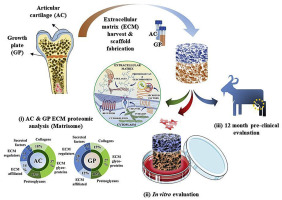当前位置:
X-MOL 学术
›
Biomaterials
›
论文详情
Our official English website, www.x-mol.net, welcomes your
feedback! (Note: you will need to create a separate account there.)
Tissue-specific extracellular matrix scaffolds for the regeneration of spatially complex musculoskeletal tissues.
Biomaterials ( IF 12.8 ) Pub Date : 2018-10-04 , DOI: 10.1016/j.biomaterials.2018.09.044 Gráinne M Cunniffe 1 , Pedro J Díaz-Payno 2 , Eamon J Sheehy 3 , Susan E Critchley 2 , Henrique V Almeida 2 , Pierluca Pitacco 2 , Simon F Carroll 2 , Olwyn R Mahon 4 , Aisling Dunne 5 , Tanya J Levingstone 6 , Conor J Moran 6 , Robert T Brady 6 , Fergal J O'Brien 7 , Pieter A J Brama 8 , Daniel J Kelly 7
Biomaterials ( IF 12.8 ) Pub Date : 2018-10-04 , DOI: 10.1016/j.biomaterials.2018.09.044 Gráinne M Cunniffe 1 , Pedro J Díaz-Payno 2 , Eamon J Sheehy 3 , Susan E Critchley 2 , Henrique V Almeida 2 , Pierluca Pitacco 2 , Simon F Carroll 2 , Olwyn R Mahon 4 , Aisling Dunne 5 , Tanya J Levingstone 6 , Conor J Moran 6 , Robert T Brady 6 , Fergal J O'Brien 7 , Pieter A J Brama 8 , Daniel J Kelly 7
Affiliation

|
Biological scaffolds generated from tissue-derived extracellular matrix (ECM) are commonly used clinically for soft tissue regeneration. Such biomaterials can enhance tissue-specific differentiation of adult stem cells, suggesting that structuring different ECMs into multi-layered scaffolds can form the basis of new strategies for regenerating damaged interfacial tissues such as the osteochondral unit. In this study, mass spectrometry is used to demonstrate that growth plate (GP) and articular cartilage (AC) ECMs contain a unique array of regulatory proteins that may be particularly suited to bone and cartilage repair respectively. Applying a novel iterative freeze-drying method, porous bi-phasic scaffolds composed of GP ECM overlaid by AC ECM are fabricated, which are capable of spatially directing stem cell differentiation in vitro, promoting the development of graded tissues transitioning from calcified cartilage to hyaline-like cartilage. Evaluating repair 12-months post-implantation into critically-sized caprine osteochondral defects reveals that these scaffolds promote regeneration in a manner distinct to commercial control-scaffolds. The GP layer supports endochondral bone formation, while the AC layer stimulates the formation of an overlying layer of hyaline cartilage with a collagen fiber architecture better recapitulating the native tissue. These findings support the use of a bi-layered, tissue-specific ECM derived scaffolds for regenerating spatially complex musculoskeletal tissues.
中文翻译:

组织特异性细胞外基质支架,用于空间复杂的肌肉骨骼组织的再生。
从组织来源的细胞外基质(ECM)产生的生物支架临床上通常用于软组织再生。这种生物材料可以增强成体干细胞的组织特异性分化,这表明将不同的ECM结构化为多层支架可以为再生受损界面组织(如骨软骨单元)的新策略奠定基础。在这项研究中,质谱用于证明生长板(GP)和关节软骨(AC)ECM包含独特的调节蛋白阵列,可能分别特别适合于骨骼和软骨修复。应用一种新颖的迭代冷冻干燥方法,制备了由AC ECM覆盖的GP ECM组成的多孔双相支架,该支架能够在空间上指导干细胞的体外分化,促进从钙化软骨过渡到透明样软骨的分级组织的发育。评估植入后12个月至临界大小的山羊骨软骨缺损的修复情况表明,这些支架以不同于商业对照支架的方式促进了再生。GP层支持软骨内骨的形成,而AC层则刺激具有胶原纤维结构的透明软骨上覆层的形成,从而更好地概括了天然组织。这些发现支持使用双层,组织特异性ECM衍生的支架再生空间复杂的肌肉骨骼组织。评估植入后12个月至临界大小的山羊骨软骨缺损的修复情况表明,这些支架以不同于商业对照支架的方式促进了再生。GP层支持软骨内骨的形成,而AC层则刺激具有胶原纤维结构的透明软骨上覆层的形成,从而更好地概括了天然组织。这些发现支持使用双层,组织特异性ECM衍生的支架再生空间复杂的肌肉骨骼组织。评估植入后12个月内达到临界大小的山羊骨软骨缺损的修复情况后发现,这些支架以不同于商业对照支架的方式促进了再生。GP层支持软骨内骨的形成,而AC层则刺激具有胶原纤维结构的透明软骨上覆层的形成,从而更好地概括了天然组织。这些发现支持使用双层,组织特异性ECM衍生的支架再生空间复杂的肌肉骨骼组织。而AC层则刺激形成具有胶原纤维结构的透明软骨上覆层,从而更好地再现天然组织。这些发现支持使用双层,组织特异性ECM衍生的支架再生空间复杂的肌肉骨骼组织。而AC层则刺激形成具有胶原纤维结构的透明软骨上覆层,从而更好地再现天然组织。这些发现支持使用双层,组织特异性ECM衍生的支架再生空间复杂的肌肉骨骼组织。
更新日期:2018-10-04
中文翻译:

组织特异性细胞外基质支架,用于空间复杂的肌肉骨骼组织的再生。
从组织来源的细胞外基质(ECM)产生的生物支架临床上通常用于软组织再生。这种生物材料可以增强成体干细胞的组织特异性分化,这表明将不同的ECM结构化为多层支架可以为再生受损界面组织(如骨软骨单元)的新策略奠定基础。在这项研究中,质谱用于证明生长板(GP)和关节软骨(AC)ECM包含独特的调节蛋白阵列,可能分别特别适合于骨骼和软骨修复。应用一种新颖的迭代冷冻干燥方法,制备了由AC ECM覆盖的GP ECM组成的多孔双相支架,该支架能够在空间上指导干细胞的体外分化,促进从钙化软骨过渡到透明样软骨的分级组织的发育。评估植入后12个月至临界大小的山羊骨软骨缺损的修复情况表明,这些支架以不同于商业对照支架的方式促进了再生。GP层支持软骨内骨的形成,而AC层则刺激具有胶原纤维结构的透明软骨上覆层的形成,从而更好地概括了天然组织。这些发现支持使用双层,组织特异性ECM衍生的支架再生空间复杂的肌肉骨骼组织。评估植入后12个月至临界大小的山羊骨软骨缺损的修复情况表明,这些支架以不同于商业对照支架的方式促进了再生。GP层支持软骨内骨的形成,而AC层则刺激具有胶原纤维结构的透明软骨上覆层的形成,从而更好地概括了天然组织。这些发现支持使用双层,组织特异性ECM衍生的支架再生空间复杂的肌肉骨骼组织。评估植入后12个月内达到临界大小的山羊骨软骨缺损的修复情况后发现,这些支架以不同于商业对照支架的方式促进了再生。GP层支持软骨内骨的形成,而AC层则刺激具有胶原纤维结构的透明软骨上覆层的形成,从而更好地概括了天然组织。这些发现支持使用双层,组织特异性ECM衍生的支架再生空间复杂的肌肉骨骼组织。而AC层则刺激形成具有胶原纤维结构的透明软骨上覆层,从而更好地再现天然组织。这些发现支持使用双层,组织特异性ECM衍生的支架再生空间复杂的肌肉骨骼组织。而AC层则刺激形成具有胶原纤维结构的透明软骨上覆层,从而更好地再现天然组织。这些发现支持使用双层,组织特异性ECM衍生的支架再生空间复杂的肌肉骨骼组织。









































 京公网安备 11010802027423号
京公网安备 11010802027423号